

– Built on Foundations of Sand - Brennpunkt. FT%20Impact%20Report%202011. Prof Yunus declines proposal to take up WB presidency. Microfinance: what IGC research says. Vikram Akula, Founder of SKS Microfinance, Says Publicly His Biggest Critic, Grameen Bank Founder Muhummad Yunus, Was Right. Mahesh Kumar A.

'Why not Yunus as World Bank chief?' Muhammad Yunus. Roger Richter for The Grameen Creative LabMuhammad Yunus, Bangladeshi economist and founder of the Grameen Bank.

Muhammad Yunus, the economist who founded Bangladesh’s Grameen Bank, visited Mumbai recently where he spoke to India Ink about his vision of “social businesses,” his forced departure from Grameen and the recent controversies that have dogged micro-finance in India and elsewhere. An edited, condensed version of the interview follows: The microfinance industry has gone through an existential crisis in the last few years. Why did the industry fall from grace? See, it’s because everybody jumped at it, because it’s such a well known, such a respected thing.
In the business world growth is the key word, if you want to put an I.P.O. and so forth. We have identified #microfranchising as a possible tool for #microfinance. Read about some interesting ongoing #microfranchise programs. Episode 31: David Roodman on Microfinance – Development Drums. Measuring the scope, defining the limits: weighing the evidence on microfinance - Events.
The Roodman-Bateman Debate: A CFI Dialogue « > Posted by Elizabeth Davidson Last Monday, January 30, Milford Bateman, author of Why Doesn’t Microfinance Work?
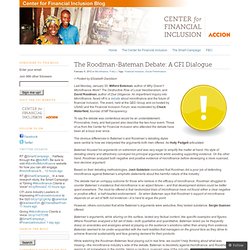
The Destructive Rise of Local Neoliberalism, and David Roodman, author of Due Diligence: An Impertinent Inquiry into Microfinance, faced off in a debate about microfinance and the future of financial inclusion. The event, held at the QED Group and co-hosted by USAID and the Financial Inclusion Forum, was moderated by Chuck Waterfield, founder of MFTransparency. To say the debate was contentious would be an understatement. Poverty Capital - Microfinance and the Making of Development. Due diligence – Current debates on Microfinance. May 11, 2012 by Markus Sundell Over the past couple of years microfinance has gone from being praised as the miracle-cure to poverty globally, to being seen as the source of poverty by maliciously capturing loan takers in loan-addiction.

Think Again: Microfinance - By David Roodman. "Microcredit Is a Proven Weapon Against Poverty.

" Alas, no. Microcredit, the strategy of lending sums as small as $100 to help poor people start tiny businesses, has won acclaim like few other recent concepts in economic development, winning plaudits from political leaders, titans of industry, and celebrities. Bill Clinton and Tony Blair love microcredit. So do Queen Rania and Natalie Portman. More than 100 million people in more than 100 countries have received microloans, thanks in no small part to billions of dollars from foreign aid agencies, philanthropists, and "social investors" looking to do well while doing good. What has made so many so sure of microcredit? But the old studies are now discredited. FORUM2. In 2009, the results from two microcredit impact studies in Hyderabad, India, and Manila, the Philippines were released to mixed responses (Banerjee, Duflo, Glennerster, and Kinnan 2010; Karlan and Zinman 2011).

Some media declared microfinance a failure (Bennett 2009). Many in the microfinance community dismissed these randomized studies as too limited to be a true reflection of the entire sector. These first randomized studies caused a sensation because they challenged the dominant impact narrative for microcredit—a narrative that rests on loans to capital-constrained microentrepreneurs who earn a steep return on marginal capital and thus can repay a relatively high interest rate and reinvest to grow out of poverty—and the way in which that narrative had been universalized in the popular imagination. CGAP>Latest Findings from Randomized Evaluations of Microfinance. Matching Products with Preferences: Innovations in Commitment Savings for the Poor. Saving is hard for most people, rich or poor, educated or not.
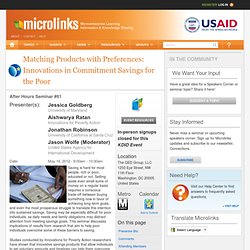
Setting aside even small sums of money on a regular basis requires a conscious trade-off between buying something now in favor of achieving long-term goals, and even the most prosperous struggle to translate this intention into sustained savings. Saving may be especially difficult for poor individuals, as daily needs and family obligations may distract attention from meeting savings goals. This seminar discusses implications of results from research that aim to help poor individuals overcome some of these barriers to saving. Studies conducted by Innovations for Poverty Action researchers have shown that innovative savings products that allow individuals to set voluntary amounts and timelines can help them overcome other demands on their money and meet their goals.
MFIs revival: Responsible lending is key - Corporate News. Updated: Sun, Mar 11 2012. 10 18 PM IST Indian microfinance institutions (MFIs) need to learn from their past mistakes and responsible lending is the key to make a fresh beginning for the industry which has shrunk from Rs 30,000 crore to half of it, following a phenomenal rise in bad debts in Andhra Pradesh that roughly accounts for one-fourth of the industry.
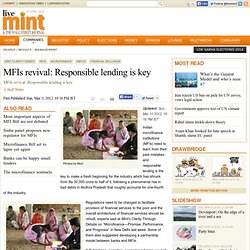
Photos by Mint Regulations need to be changed to facilitate provision of financial services to the poor and the overall architecture of financial services should be rebuilt, experts said at Mint’s Clarity Through Debate on “Microfinance—Promise, Performance, and Prognosis” in New Delhi last week. Some of them also suggested developing a partnership model between banks and MFIs. K.P. Microfinance Gateway>Postcard from Spain: The 2011 Global Microcredit Summit. Postcard from Spain: The 2011 Global Microcredit Summit The Microcredit Summit Campaign's "7 steps for recovering the soul of microfinance.
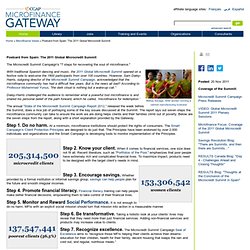
" With traditional Spanish dancing and music, the 2011 Global Microcredit Summit opened on a festive note to welcome the 1800 participants from over 100 countries. However, Sam Daley-Harris, outgoing director of the Microcredit Summit Campaign, acknowledged that the microfinance community has had a difficult few years. But is the news all bad? World Development - The Impact of Microfinance in Sub-Saharan Africa: A Systematic Review of the Evidence.
Open Access Summary Microfinance is seen as a key development tool, and despite the current deepening crisis within the industry, it continues to grow in sub-Saharan Africa.
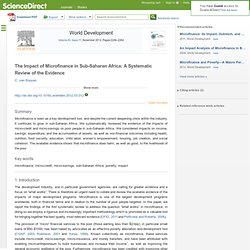
We systematically reviewed the evidence of the impacts of micro-credit and micro-savings on poor people in sub-Saharan Africa. We considered impacts on income, savings, expenditure, and the accumulation of assets, as well as non-financial outcomes including health, nutrition, food security, education, child labor, women’s empowerment, housing, job creation, and social cohesion. Impact of microfinance on education in sub-Saharan Africa. Correlation or Causation? David Graeber's Debt reviewed by Justin E. H. Smith in Bookforum - The World. The Naked Truth about Microfinance Loans - Rising Tide - Water For People. There are Summits, and then there are Summits... - Home - Savings Revolution.
My Impressions from the Global Microcredit Summit in Spain… Americas Quarterly - Not So Fast: The Realities of Impact Investing. At the beginning of 2010, the Indian microfinance sector was a hotspot for impact investors. The promise of impact investing could be seen in the number of investors lining up to participate in the initial public offering (IPO) of SKS Microfinance. SKS had ballooned from 603,000 borrowers in fiscal year 2007 to 6.8 million in fiscal year 2010. Most were women in South Indian villages. Latest Impact Research: Inching Towards Generalization. The most rapidly obsolescing part of my book, Due Diligence, is chapter 6, which reviews the statistical evidence of the impact of microfinance on poverty. Since I put the text to bed, working papers have appeared that test microcredit in Mongolia and Bosnia & Herzegovina and microsavings in Malawi and Chile (though the latter is marked “do not cite or circulate”).
There’s also the Morocco microcredit study, which I didn’t catch wind of until too late in the book production. Add all these to the trials of microcredit in India and the Philippines and of microsavings in Kenya—the one that initiated this wave of research in 2009—and we have five credit studies and three savings ones. From Poverty to Power by Duncan Green. April is the Month of Microfinance. Banks are prudentially regulated and supervised to protect their depositors and to prevent risks to the financial system.
Credit-only MFIs that do not take voluntary savings from the public pose little risk to the financial system, if any, and can generally be handled with less intensive non-prudential regulation. Non-prudential regulation addresses such topics as consumer disclosure and recourse or anti-money laundering and combating financing of terrorism (AML/CFT) that do not depend on the financial health of the regulated provider. Prudential regulation and supervision, which do aim to protect the solvency of license holders, are appropriate for most MFIs that take voluntary deposits—for instance, savings-based financial cooperatives or credit-only MFIs that want to start attracting savings to finance their growth.
In many countries, various stakeholders push for new laws or regulations creating a specialized type of financial license for deposit-taking MFIs. Is Microcredit Over-Indebtedness a Worldwide Problem? CGAP has just published a study that Jessica Schicks and I have written on over-indebtedness among microborrowers. The paper is not exactly bedtime reading: I’m slightly embarrassed to say that it runs to 43 pages. So some readers may feel like the third grade student whose book review began, “This book told me more about whales than I wanted to know.” It’s been an interesting exercise to go back over the paper’s detailed discussion and cull out a few conclusions that feel important enough to highlight in a blog. The first big message has to do with the question in this blog’s title.
SEEP Network. Why Doesn't Microfinance Work?: A Review. 2005 was the "International Year of Microcredit", celebrating an industry thought by some to be a panacea for the developing world. UKCDS Event Details. China to form Savings Groups in Africa - Home - Savings Revolution. A consortium made up of Shenzhen Development Bank, the Hang Lung Group and Lenovo have announced a major initiative to bring savings groups to Africa on a scale never before imagined. The group, through a joint venture called Virtual Sharing Resources Applications (VSRA), plans to introduce very low cost savings group kits with illustrated instruction sheets through retail outlets across the continent. T.co / Twitter.
Microfinance Gateway>Does microfinance work? A too-generalized look at microfinance. Microcredit doesn’t end poverty, despite all the hype. The Mongolian Microfinance Experiment. Flipthecoin.org. Posted on Jan 21st, 2012 A personal comment published in “The African Report” on January 21. 2012 By: Tom Heinemann In December 2007, we met with a woman by the name of Jahanara – living in a slum-like house two hours drive outside the Bangladeshi capital, Dhaka.
‘Women are useful to microfinance: how can we make microfinance more useful for women?’ – International Women’s Day event in parliament. Micro-enterprise romanticism « kariobangi. Melanie Walker: From Microfinance to Metafinance: A New Tool to Fight Global Poverty. At midnight on October 31, 2011, an eight-pound boy named Pyotr Nikolayeva was born in the western Russian city of Kaliningrad. The Nikolayeva family was probably too busy welcoming their third child into the world to recognize that Pyotr had become, according to Forbes magazine, our planet's seven billionth resident. Seven billion. That's twice the number of people who lived on earth 40 years ago, and experts predict that there will be nearly 10 billion of us 40 years from now, when human population growth is finally expected to peak. Microfinance CEOs Unite on Road Map to Responsible Microfinance « 1425842_file_Roodman_Due_Diligence_brief_FINAL. 6 myths about microfinance charity that donors can do without.
Lorenzo Natali Journalism Prize. Investing With Heart and Head. Markets / Stock Markets : Private equity players staying away from MFIs.